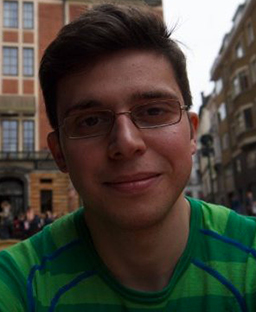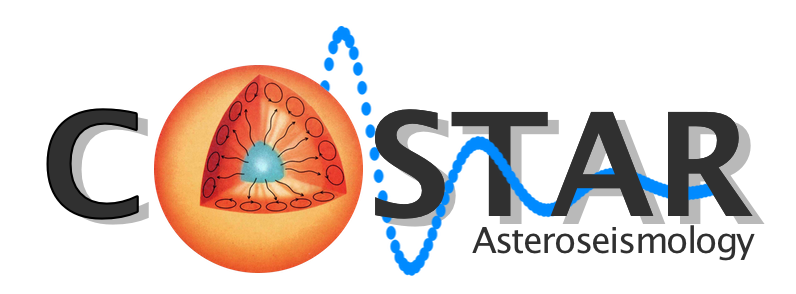 AstroFIt 2 – COFUND fellow since October 1, 2016.
AstroFIt 2 – COFUND fellow since October 1, 2016.
Project ended on September 30, 2019.
INAF Research Centre: Osservatorio Astrofisico di Catania
Email: enrico.corsaro at inaf.it
In the media:
- Oscillazioni solari nel riflesso di Nettuno (Media INAF, 19/12/2016)
- Stelle, c’è un imprinting familiare sullo spin (Media INAF, 13/3/2017)
- Dimmi come ribolli e ti dirò che metallicità hai (Media INAF, 28/7/2017)
- Una bilancia per pesare le stelle (Media INAF, 18/12/2017) ANSA, EurekAlert!
- Ecco le due super-terre gemelle ma diverse (Media INAF, 4/2/2019)
- Orbitando ai confini di una gigante rossa (Media INAF, 30/10/2019)
Talks:
- Formation history of old open clusters constrained by detailed asteroseismology of red giant stars observed by Kepler
- Spin alignment of stars in old open clusters
- Metallicity effect on stellar granulation detected from red giants in open clusters
Papers/Publications:
- A distant mirror: solar oscillations observed on Neptune by the Kepler K2 mission (The Astrophysical Journal Letters, 10/12/2016)
- Spin alignment of stars in old open clusters (Nature Astronomy, 13/3/2017)
- Metallicity effect on stellar granulation detected from oscillating red giants in open clusters (Astronomy & Astrophysics, 19/7/2017)
- Photospheric activity of the Sun with VIRGO and GOLF: comparison with standard activity proxies (Astronomy & Astrophysics, 14/9/2017)
- Empirical Accurate Masses and Radii of Single Stars with TESS and Gaia (The Astronomical Journal, January 2018)
- FliPer: Checking the reliability of global seismic parameters from automatic pipelines (Société Francaise d’Astronomie et d’Astrophysique (SF2A) 2017)
- Asteroseismology of KIC 7107778: a binary comprising almost identical subgiants (MNRAS, 29/1/2018)
- The Second APOKASC Catalog: The Empirical Approach (The Astronomical Journal Supplement Series, 2018 December)
- Bayesian peak bagging analysis of 19 low-mass low-luminosity red giants observed with Kepler (Corrigendum) (Astronomy & Astrophysics, 612, April 2018)
- The Rotational Shear Layer inside the Early Red-giant Star KIC 4448777 (The Astronomical Journal, 20/7/2018)
- Oscillating red giants in eclipsing binary systems: empirical reference value for asteroseismic scaling relation (MNRAS, 478, 2018)
- FliPer: A global measure of power density to estimate surface gravities of main-sequence solar-like stars and red giants (Astronomy & Astrophysics, 27/11/2018)
- Predicting Granulation “Flicker” and Radial Velocity “Jitter” from Spectroscopic Observables (The Astronomical Journal, 12/12/2018)
- A giant impact as the likely origin of different twins in the Kepler-107 exoplanet system (Nature Astronomy, 4/2/2019)
- The Helium Abundance of NGC 6791 from Modeling of Stellar Oscillations (The Astrophysical Journal, 5/4/2019)
- Fast and Automated Oscillation Frequency Extraction Using Bayesian Multi-Modality (Frontiers in Astronomy and Space Sciences, 9/4/2019)
- First detection of oscillations in the Halo giant HD 122563: validation of seismic scaling relations and new fundamental parameters (Astronomy & Astrophysics, 7/5/2019)
- A Hot Saturn Orbiting An Oscillating Late Subgiant Discovered by TESS (The Astronomical Journal, 30/5/2019)
- Determining the Best Method of Calculating the Large Frequency Separation For Stellar Models (The Astrophysical Journal, 1/7/2019)
- Acoustic oscillations and dynamo action in the G8 sub-giant EK Eri (Astronomy & Astrophysics, 3/7/2019)
- TESS Asteroseismology of the Known Red-giant Host Stars HD 212771 and HD 203949 (The Astrophysical Journal, 29/10/2019)
Project title: COSTAR – COnstrain STellar physics using all-sky AsteRoseismology
Abstract:
Internal rotation, angular momentum transport, convection, and mass loss are among the least understood dynamical processes occurring in stars. How these processes interact and influence stellar structure and evolution is a major challenge in stellar physics. The only way to answer this fundamental question is through in-depth asteroseismology of solar-like stars spanning a wide range of fundamental properties, evolutionary stages, and galactic regions. 
The observed solar-like pulsating stars are currently around 40 thousands. Still, only about 100 of them have been characterized using in-depth asteroseismology. Given the large diversity of stars in the Galaxy, this sample is too small to provide a solid statistics. Besides, the detailed asteroseismic analysis is a very challenging problem that only few specialists in the world are able to perform. Existing techniques are limited in terms of both efficiency and automation. Within the next 10 years we will have to face the analysis of a million of stars, hence a strong effort urges to bridge this big gap.
Leveraging my forefront research in innovative approaches for asteroseismology, with the Bayesian code DIAMONDS as proof of concept, COSTAR will fully characterize the oscillations for 2 thousands solar-like pulsators using all-sky observations. By combining the new results with spectroscopic surveys (e.g. APOGEE) and astrometry (Gaia), COSTAR will thus develop new constraints that will bring stellar physics to a new level of understanding by taking into account the dynamics and their impact on the structure of stars throughout the stellar evolution.
COSTAR will also provide key stellar properties for improving galactic and planetary science. The success of this ambitious project requires the commitment of a competent scientist with the proper resources and the optimal time frame provided by the present call for proposals.
Here I am:
